Table of Contents
- Understanding Change Management in the Digital Era
- The Science of Change Resistance: Why Humans Struggle with Transformation
- The Role of AI and Automation in Modern Change Management
- The 5-Step Change Management Framework for Digital Transformation
- Industry-Specific Change Management Best Practices
- Measuring Change Success: Key metrics, ROI benchmarks, and value demonstration
- Comprehensive Measurement Framework
- ROI Calculation for Change Management
- Leveraging Technology for Change Measurement
- Building a Change Measurement Culture
- Change Management Best Practices and Common Pitfalls
- Choosing the Right Change Management Software Solution
- Apty: The AI-Powered Change Management Solution for Digital Transformation Success
- The Future of Change Management is AI-Powered
- Apty vs. Traditional Tools: Change Management Capability Comparison
- Conclusion: Embracing Change as a Strategic Advantage
Are you ready for the hard truth? Many organizations spend millions on digital transformation only to see their software go underutilized. According to McKinsey, 70% of digital transformations fail, and poor change management is often the reason.
This guide is designed to help you solve that problem. We’ll show you how modern change management software can be the missing link between technology implementation and real success. Through a five-step framework, AI innovations, and industry-specific best practices, you’ll learn how to maximize user adoption and drive measurable outcomes from your transformation efforts.
Whether you’re a change management leader, IT director, or executive sponsor, this blueprint will provide you with the tools, strategies, and insights you need to ensure your digital transformation delivers real business results.
Understanding Change Management in the Digital Era
Digital transformation has become an imperative for organizations seeking to remain competitive. However, the stark reality is that 70% of digital transformation initiatives fail to reach their stated goals. The primary reason isn’t technological failure but human resistance to change.
Change management addresses this human element by providing a structured approach to transitioning individuals, teams, and organizations from a current state to a desired future state. In the digital context, effective software for change management becomes essential for scaling this approach across complex enterprises.
The Evolution of Change Management
Change management has evolved significantly over the past decades:
- First Generation (1990s): Focused primarily on communication and training, with limited tools beyond spreadsheets and project plans. Change management was often an afterthought to technical implementation.
- Second Generation (2000s-2010s): Introduced more structured methodologies (ADKAR, Kotter, etc.) and basic change management tools. Organizations began to recognize change management as a distinct discipline that requires specialized skills.
- Third Generation (Current): Leverages data analytics, AI, and digital adoption platforms to deliver personalized, adaptive change experiences at scale. Modern management of change software offers unprecedented visibility into adoption patterns, enabling proactive interventions.
The Business Case for Formal Change Management
Organizations that employ effective change management practices are significantly more likely to achieve project objectives. Research by Prosci indicates that initiatives with excellent change management are six times more likely to meet or exceed objectives than those with poor change management.
The financial implications are substantial:
- Projects with effective change management deliver results 67% more efficiently.
- Change-managed projects are 2.5 times more likely to stay on or under budget
- Organizations with mature change capabilities experience 34% higher ROI on transformation initiatives
The Science of Change Resistance: Why Humans Struggle with Transformation
To effectively manage change, we must first understand why people resist it. This resistance isn’t merely organizational dysfunction or employee stubbornness—it’s rooted in fundamental aspects of human psychology and neurobiology.
The Neurological Basis of Change Resistance
From a neurological perspective, change activates the brain’s threat response system. When confronted with significant changes to established routines:
- The amygdala activates, triggering the fight-or-flight response
- Cortisol levels increase, creating stress and reducing cognitive function
- The prefrontal cortex (responsible for rational thinking) becomes less active
- Cognitive biases like loss aversion and status quo bias strengthen
This neurological response explains why even positive changes can trigger resistance.
The brain perceives uncertainty as a potential threat, regardless of the rational benefits the change might bring. The customer-first approach driving digital transformation in retail offers valuable insights for internal change management strategies.
Barriers Are Inevitable. Stopping at Them Isn’t.
Discover how Apty enables enterprises to overcome resistance and drive successful change with in-app guidance and real-time user insights.
The Emotional Journey of Change
Beyond the neurological response, individuals experiencing change typically progress through predictable emotional stages:
- Denial: Initial disbelief or minimization of the change’s impact
- Resistance: Active or passive opposition as the reality of change sets in
- Exploration: Tentative engagement with new possibilities
- Commitment: Acceptance and integration of the change
Understanding where individuals and groups are in this emotional journey allows change leaders to provide appropriate support at each stage. Modern software change management tools can help track and visualize this progression across large organizations.
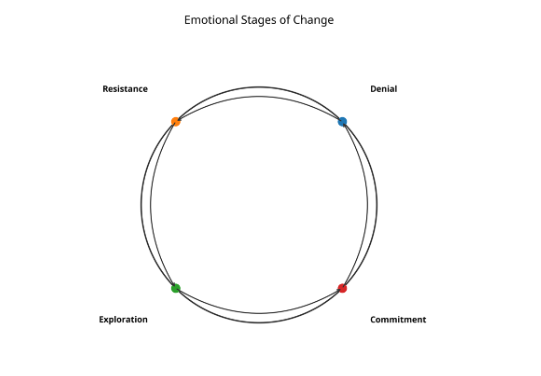
Common Resistance Patterns in Digital Transformation
Digital transformation initiatives typically encounter several specific resistance patterns:
- Fear of Obsolescence: Employees worry that new technologies will make their skills irrelevant or even eliminate their positions entirely.
- Competence Concerns: Even talented employees may resist changes that make them feel temporarily incompetent during the learning curve.
- Workload Anxiety: The perception that new systems will create additional work, especially during transition periods.
- Loss of Control: Digital systems often standardize processes, potentially reducing individual autonomy or discretion.
- Skepticism from Past Failures: In organizations with histories of unsuccessful technology implementations, employees develop “change fatigue” and cynicism.
Effective change management addresses these patterns through targeted interventions, many of which can be automated and scaled through change management software.
The Role of AI and Automation in Modern Change Management
Artificial intelligence is transforming change management from an art to a data-driven science. By leveraging AI capabilities, organizations can deliver more personalized, effective, and scalable change experiences.
How AI is Revolutionizing Change Management
AI enhances change management across multiple dimensions:
- Personalization at Scale: Traditional change management often relied on one-size-fits-all approaches. AI enables tailored experiences based on individual roles, learning styles, and adoption patterns.
- Predictive Analytics: Rather than reacting to resistance after it emerges, AI can identify potential adoption challenges before they manifest by analyzing patterns in user behavior and sentiment.
- Continuous Optimization: AI systems continuously learn from user interactions, allowing change strategies to evolve based on what’s working and what isn’t.
- Automated Support: Virtual assistants and chatbots provide 24/7 guidance, answering questions and resolving issues without human intervention.
- Content Generation: AI can help create and customize training materials, video presentations, communications, and documentation, significantly reducing the time investment required.
The Human-AI Partnership in Change Management
| Feature | Traditional Change Management | AI-Enhanced Change Management |
| Personalization | One-size-fits-all approach | Tailored to individual user needs and learning styles |
| Timing | Scheduled, calendar-driven | Just-in-time, context-aware guidance |
| Scalability | Limited by human resources | Infinitely scalable across the organization |
| Insights | Retrospective, survey-based | Real-time, behavior-based analytics |
| Adaptation | Manual adjustments based on feedback | Continuous self-optimization based on usage patterns |
| Support | Limited to business hours | 24/7 availability with virtual assistants |
| Prediction | Based on historical patterns | Predictive analytics identifies potential issues before they occur |
| Content Creation | Time-intensive manual development | Automated generation with human refinement |
| Measurement | Periodic assessment | Continuous monitoring and real-time dashboards |
AI-Driven Components:
- Data collection and analysis
- Pattern recognition across large user populations
- Personalized content delivery
- Routine support and guidance
- Progress tracking and reporting
- Emotional support during transition
- Complex problem-solving
- Strategic decision-making
- Executive sponsorship and advocacy
- Cultural alignment and values integration
The 5-Step Change Management Framework for Digital Transformation
Successful digital transformation requires a structured approach to change management. This five-step framework offers a comprehensive roadmap that can be tailored to any organization’s unique context and challenges.
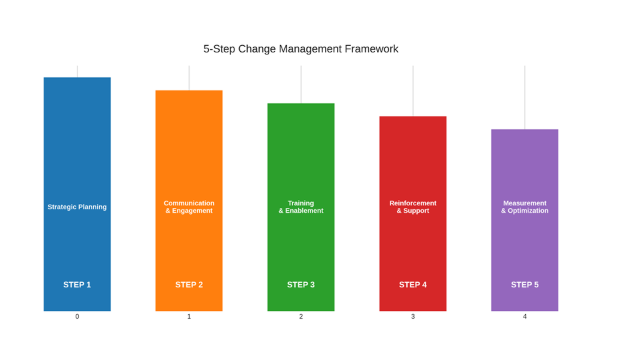
Step 1: Strategic Planning
Effective change management begins well before implementation. The planning phase establishes the foundation for all subsequent activities:
- Change Impact Assessment: Analyze how the digital transformation will affect different stakeholder groups, processes, and organizational structures. Document current state workflows and compare them to future state expectations.
- Stakeholder Analysis: Identify all groups affected by the change, assess their influence and interest levels, and develop targeted engagement strategies for each segment.
- Resistance Mapping: Anticipate potential sources of resistance based on organizational history, cultural factors, and the specific nature of the change.
- Resource Planning: Determine the budget, personnel, and tools needed to support the change process, including change management software requirements.
- Success Metrics Definition: Establish clear, measurable objectives for both technical implementation and user adoption to guide the change effort and demonstrate value.
Step 2: Communication and Engagement
Communication is the cornerstone of effective change management, creating awareness and building desire for the change:
- Message Framework Development: Create core messaging that clearly articulates the “why” behind the change, addressing the WIIFM (“What’s in it for me?”) for each stakeholder group.
- Communication Channel Selection: Identify the most effective channels for reaching different audiences, considering both formal (email, intranet) and informal (team meetings, social networks) options.
- Leadership Alignment: Ensure consistent messaging across leadership levels, with executives, middle managers, and team leaders all conveying the same core narrative.
- Two-Way Communication Mechanisms: Establish feedback channels that allow stakeholders to ask questions, express concerns, and contribute ideas throughout the process.
- Celebration of Quick Wins: Identify and publicize early successes to build momentum and demonstrate progress toward the larger transformation goals.
Great Change Starts with Great Communication
Explore the key elements that make communication a driving force in successful change management. Read our full blog here.
Step 3: Training and Enablement
Training transforms awareness into ability, giving stakeholders the skills and knowledge needed to succeed in the new environment:
- Training Needs Analysis: Assess the gap between current and required skills for each role affected by the change, then design targeted learning interventions.
- Multi-Modal Learning Approach: Develop diverse training formats (instructor-led, self-paced, simulation-based) to accommodate different learning styles and practical constraints.
- Just-in-Time Learning: Leverage software change management tools to deliver guidance at the moment of need, rather than relying solely on pre-implementation training.
- Performance Support Tools: Create job aids, quick reference guides, and in-application help to support users after formal training concludes.
- Capability Certification: Establish clear competency milestones and recognize achievement to motivate skill development and identify areas needing additional support.
Step 4: Reinforcement and Support
Reinforcement transforms initial adoption into sustained behavior change:
- Adoption Monitoring: Use analytics from change management software to track usage patterns and identify areas where adoption is lagging.
- Targeted Interventions: Develop specific strategies for addressing adoption challenges, from additional training to process adjustments or system modifications.
- Recognition Programs: Acknowledge and reward individuals and teams demonstrating successful adoption and helping others adapt.
- Community Building: Create forums where users can share experiences, tips, and workarounds, fostering a collaborative learning environment.
- Manager Enablement: Equip supervisors with tools and talking points to reinforce the change message and support their teams through the transition.
Step 5: Measurement and Optimization
The final step involves measuring outcomes and continuously improving the change approach:
- Adoption Metrics Tracking: Monitor user engagement, feature utilization, and process compliance to assess the depth and breadth of adoption.
- Business Outcome Measurement: Connect adoption metrics to the business outcomes that motivated the transformation, demonstrating tangible value.
- Feedback Collection: Gather structured input from users about their experience with both the technology and the change management process.
- Lessons Learned Documentation: Capture insights about what worked and what didn’t to inform future change initiatives.
- Continuous Improvement: Use data and feedback to refine the change approach in real-time, addressing emerging challenges and opportunities.
This framework provides a comprehensive approach to managing change throughout the digital transformation lifecycle. When implemented with appropriate change management software, it significantly increases the likelihood of achieving desired business outcomes.
Industry-Specific Change Management Best Practices
While change management principles remain consistent across sectors, their application must be tailored to industry-specific challenges, stakeholder considerations, and regulatory environments.
Healthcare Change Management
Healthcare organizations face unique challenges when implementing new technologies:
- Patient Safety Considerations: Changes must be implemented without compromising care quality or patient safety, often requiring more extensive testing and parallel processes during transition.
- Clinical Workflow Sensitivity: Physicians and nurses operate in high-pressure environments where efficiency is critical; changes that disrupt established workflows face intense resistance.
- Regulatory Compliance Requirements: Healthcare technologies must meet strict regulatory standards (HIPAA, HITECH, etc.), adding complexity to implementation and training.
- Diverse Stakeholder Groups: Changes must accommodate the needs of clinical staff, administrative personnel, IT teams, and, in some cases, patients, each with distinct priorities and concerns.
Best practices for healthcare change management include:
- Involving clinical champions early in the process
- Emphasizing patient outcome benefits rather than technical features
- Implementing changes in phases to minimize disruption
- Providing at-elbow support during critical go-live periods
- Using regulatory change management software to ensure compliance throughout the process
Financial Services Change Management
Financial institutions operate in highly regulated environments with minimal tolerance for error:
- Security and Compliance Focus: Changes must maintain or enhance security controls while meeting evolving regulatory requirements.
- Risk-Averse Culture: The industry’s conservative nature often creates stronger-than-average resistance to change.
- Customer Impact Sensitivity: Changes affecting customer-facing systems must be seamless to maintain trust and service quality.
- Complex System Interdependencies: Financial systems often have numerous connections and dependencies, complicating the change process.
Best practices for financial services change management include:
- Framing changes in terms of risk mitigation and compliance benefits
- Developing robust audit trails for all aspects of the change process
- Engaging compliance and security teams from the earliest planning stages
- Creating detailed rollback plans for every implementation phase
- Using regulatory change management software to document compliance steps
Manufacturing Change Management
Manufacturing environments present distinct change management challenges:
- 24/7 Operations: Many facilities can’t afford downtime, requiring changes to be implemented without disrupting production.
- Safety Considerations: Changes must maintain or enhance safety protocols in potentially hazardous environments.
- Diverse Workforce: Manufacturing teams often include varying education levels, technical comfort, and language preferences.
- Union Considerations: Organized labor agreements may affect how changes can be implemented and what support must be provided.
Best practices for manufacturing change management include:
- Minimizing production disruption through careful implementation scheduling
- Leveraging shift supervisors and team leads as change champions
- Providing multilingual training and support materials
- Using hands-on, practical training approaches rather than theoretical instruction
- Implementing changes during planned maintenance periods when possible
Industry-Specific Comparison
The following table summarizes key differences in change management approaches across industries.
| Industry | Key Change Management Challenges | Best Practices |
| Healthcare | • Regulatory compliance requirements • Patient safety concerns • Clinical workflow disruption • Multiple stakeholder groups (clinical, administrative, technical) |
• Involve clinical champions early • Emphasize patient outcomes • Implement phased rollouts • Provide at-elbow support during go-live |
| Financial Services | • Strict security requirements • Complex compliance landscape • Risk-averse culture • High performance expectations |
• Focus on risk mitigation • Develop robust audit trails • Engage compliance early • Emphasize security benefits |
| Manufacturing | • 24/7 operations • Safety considerations • Union involvement • Diverse workforce technical skills |
• Minimize production disruption • Leverage shift supervisors as champions • Provide multilingual support • Use hands-on training approaches |
| Retail | • Geographically dispersed locations • High employee turnover • Seasonal workforce fluctuations • Customer-facing impact |
• Develop train-the-trainer models • Create simple, visual guides • Implement during off-peak seasons • Focus on customer experience benefits |
| Government | • Procurement constraints • Public accountability • Legacy systems integration • Political considerations |
• Align with agency mission • Build cross-department coalitions • Document decision-making processes • Develop comprehensive business cases |
Measuring Change Success: Key metrics, ROI benchmarks, and value demonstration
In the business world, what gets measured gets managed, and what demonstrates value gets funded. While organizations increasingly recognize the importance of change management, many still struggle to quantify its impact and justify investment in comprehensive change management programs.
The Evolution of Change Management Measurement
Measurement approaches for change management have evolved significantly over time, reflecting the discipline’s maturation:
First Generation: Activity-Based Metrics
Early change management measurement focused primarily on tracking activities:
- Number of communications sent
- Training sessions conducted
- Employees trained
- Support materials created
While these metrics demonstrated effort, they provided little insight into effectiveness or business impact.
Second Generation: Adoption Metrics
As the discipline evolved, focus shifted to measuring actual adoption:
- System login rates
- Feature utilization
- Process compliance
- Error rates
- Support ticket volumes
These metrics provided better insight into whether employees were actually using new systems or processes as intended.
Third Generation: Business Outcome Metrics
The current generation of change management measurement connects change initiatives directly to business results:
- Productivity improvements
- Cost reductions
- Revenue impacts
- Customer satisfaction changes
- Quality enhancements
This approach demonstrates the tangible value of change management in terms that resonate with executives.
Comprehensive Measurement Framework
A complete change management measurement framework should include metrics across multiple dimensions:
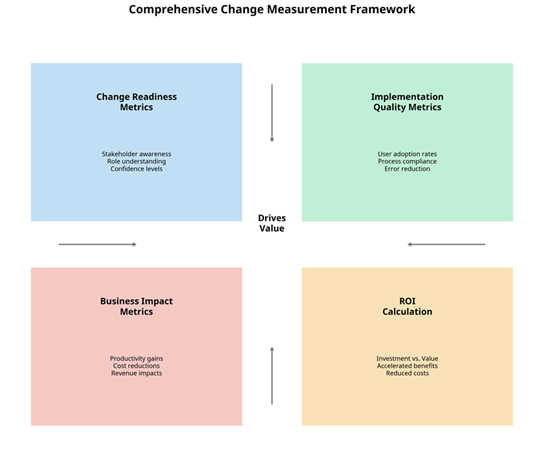
1. Change Readiness Metrics: These metrics assess organizational preparedness before implementation:
- Percentage of stakeholders who can accurately describe the change
- Level of understanding of how the change will affect specific roles
- Confidence in the ability to adapt to new requirements
- Communication effectiveness (message penetration, comprehension)
- Training completion rates and knowledge assessment scores
- Leadership engagement in supporting the change
2. Implementation Quality Metrics: These measure the effectiveness of change management activities:
- Response time for support requests
- Active user rates (daily/weekly/monthly)
- Feature utilization rates
- Process compliance percentages
- Error rates and types
- Workaround frequency
3. Business Impact Metrics: These connect change management to business outcomes:
- Process cycle time reductions
- Labor hours saved
- Error reduction percentages
- Customer satisfaction changes
- Cost reductions or revenue increases
ROI Calculation for Change Management
Calculating the return on investment (ROI) for change management requires comparing the costs of change management activities against the value they create:
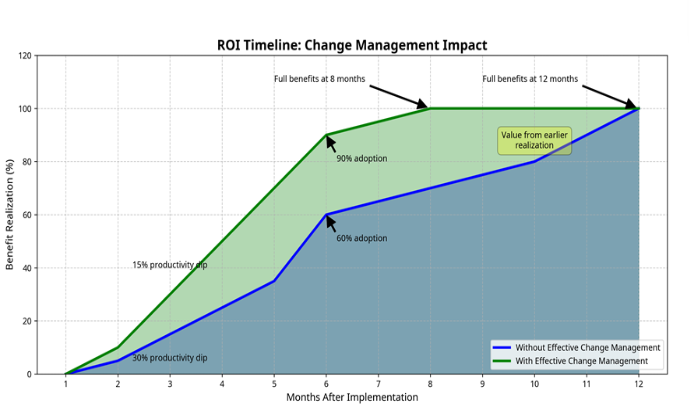
Change Management Investment:
- Personnel costs (change management team, portion of project team time)
- External consultant fees
- Training, development, and delivery costs
- Digital adoption platform licensing
- Support resources and tools
Value Created:
- Earlier benefit realization through faster adoption
- Higher ultimate adoption increases total benefits
- Reduced productivity dip during transition
- Lower support costs due to better preparation
- Decreased resistance and workarounds
Comparison Example:
Without Effective Change Management
- 60% adoption after 6 months
- Full productivity benefits are achieved after 12 months
- 30% productivity dip during the first 3 months
- High support costs due to confusion and resistance
With Effective Change Management
- 90% adoption after 6 months
- Full productivity benefits achieved after 8 months
- 15% productivity dip during the first 3 months
- Lower support costs due to better preparation
Value Quantification Example:
- Earlier benefit realization: $400,000
- Higher ultimate adoption: $350,000
- Reduced productivity dip: $200,000
- Lower support costs: $100,000
- Total Value: $1,050,000
Leveraging Technology for Change Measurement
Modern software change management tools provide powerful capabilities for measuring change effectiveness:
Usage Analytics: Digital adoption platforms like Apty offer detailed usage analytics that:
- Track which features are being used and by whom
- Identify where users are struggling or abandoning processes
- Measure time spent on different activities
- Detect workarounds and non-standard processes
Sentiment Analysis: AI-powered change management and DAP tool like Apty can:
- Process feedback from surveys, help desk interactions, and communication channels
- Identify emerging concerns or resistance
- Track sentiment changes over time
- Compare sentiment across different stakeholder groups
Predictive Analytics: Advanced change management software like Apty can provide:
- Forecasting adoption rates based on early indicators
- Predicting which user groups might struggle based on historical patterns
- Identifying potential resistance hotspots before they emerge
- Estimating time-to-proficiency for different user segments
Building a Change Measurement Culture
Beyond specific metrics and tools, organizations need to develop a culture that values and acts on change measurement:
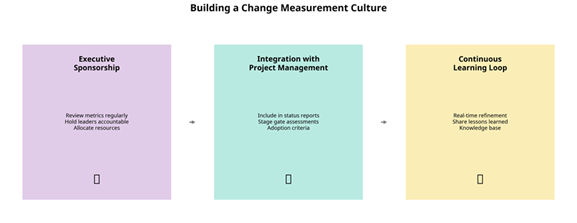
Executive Sponsorship for Measurement: Ensure that executives:
- Request and review change adoption metrics regularly
- Include adoption measures in project success criteria
- Hold leaders accountable for adoption outcomes
- Allocate resources based on measurement insights
Integration with Project Management: This includes:
- Including adoption metrics in project status reporting
- Reviewing change readiness assessments at stage gates
- Making go/no-go decisions based partly on adoption readiness
- Extending project closure criteria to include adoption targets
Continuous Learning Loop: Establish processes for:
- Using measurement insights to refine change approaches in real-time
- Sharing lessons learned across initiatives
- Building an organizational knowledge base of what works
Change Management Best Practices and Common Pitfalls
Drawing from decades of research and practical experience, these best practices and common pitfalls provide valuable guidance for organizations implementing change management programs.
Critical Success Factors
1. Active and Visible Executive Sponsorship
- Executive sponsors must go beyond nominal approval to actively champion the change:
- Communicate directly with employees about the importance of the change
- Allocate sufficient resources to change management activities
- Participate visibly in key change events
- Hold managers accountable for supporting their teams through the transition
- Address resistance at senior levels of the organization
2. Dedicated Change Management Resources
- Successful initiatives require dedicated change management expertise:
- Assign professionals with specialized change management training
- Ensure appropriate staffing levels (typically 10-15% of project resources)
- Integrate change team with project team from the outset
- Provide change practitioners with appropriate authority and access
- Develop internal change capability for sustainable results
3. Structured Methodology
A consistent, repeatable approach provides the foundation for success:
- Adopt a proven change management framework
- Customize the methodology to your organizational context
- Document the approach for consistent application
- Train project teams on the methodology
- Continuously improve based on results
4. Engaged Middle Management
Middle managers play a crucial role as the “bridge” between executive vision and frontline reality:
- Equip managers with tools and talking points to support their teams
- Address managers’ personal concerns about the change early
- Recognize and reward managers who effectively lead change
- Create peer forums where managers can share challenges and solutions
- Hold managers accountable for adoption within their teams
5. Frequent and Transparent Communication
Effective communication builds awareness, desire, and trust:
- Develop a comprehensive communication plan with an appropriate frequency
- Tailor messages to different stakeholder groups
- Use multiple channels to reach diverse audiences
- Address the “why” before the “what” and “how”
- Create opportunities for two-way dialogue
Change Management Checklist
Use this checklist to evaluate your organization’s readiness for implementing change management processes:
Executive Sponsorship
- Executive sponsor identified and actively engaged
- Sponsor understands their role in the change process
- Sponsor has allocated appropriate resources
- Sponsor regularly communicates the importance of the initiative
Change Management Team
- Dedicated change management resources assigned
- Team members have appropriate skills and training
- Roles and responsibilities are clearly defined
- Integration with the project management team established
Stakeholder Analysis
- Key stakeholder groups identified
- Impact assessment completed for each group
- Influence mapping conducted
- Resistance points anticipated
Communication Planning
- Key messages developed for each stakeholder group
- Communication channels identified
- Communication frequency determined
- Feedback mechanisms established
Choosing the Right Change Management Software Solution
With numerous options available, selecting the appropriate change management software requires careful evaluation of your organization’s specific needs and objectives.
Core Capabilities to Consider
When evaluating change management solutions, consider these essential capabilities:
- User Adoption Tracking: The ability to monitor how employees interact with new systems, including:
- Login frequency and duration
- Feature utilization rates
- Task completion metrics
- Workflow adherence
- Step-by-step walkthroughs
- Tooltips and help bubbles
- Process validation
- Error prevention
- Training content authoring
- Knowledge base management
- Communication template libraries
- Multi-format content support
- Adoption dashboards
- Usage pattern analysis
- Struggle detection
- ROI calculation
- HRIS integration
- LMS connectivity
- Project management tool integration
- Single sign-on support
Apty: The AI-Powered Change Management Solution for Digital Transformation Success
Traditional change management approaches often fall short when applied to complex digital transformations, creating a gap between technology implementation and actual business value realization. Apty goes beyond software feature adoption and transforms the change management paradigm by addressing the entire digital transformation journey. Apty serves as the essential bridge between technology implementation and successful organizational change.
From Adoption-Focused to Change Management-Driven
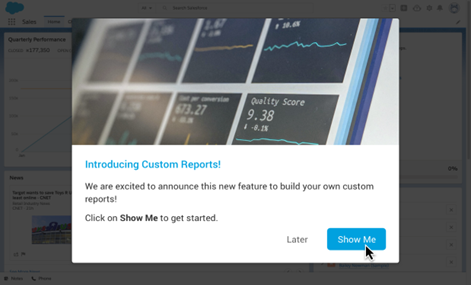
Traditional change management software focuses on documenting processes and providing basic guidance. Apty elevates change management to a strategic business function by:
- Automatically push Announcements, Launchers, or other notifications with a strong call to action.
- Launch new applications and processes—proactively push in-the-moment support and training.
- Accelerates change readiness by reducing resistance through contextual guidance and support
- Ensures process compliance and standardization across the organization during transitions
- Provides real-time analytics on adoption, usage, and business outcomes
- Delivers 3.4x ROI in year one
AI-Powered Change Intelligence: The Apty Difference
At the heart of Apty’s differentiation is its advanced AI engine that revolutionizes how organizations manage digital change:
- Predictive Change Guidance: Unlike static change management tools, Apty’s AI anticipates user challenges during transitions and proactively offers assistance before resistance develops.
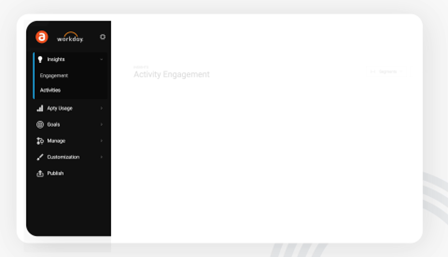
- Intelligent Process Optimization: Apty’s AI continuously analyzes user interactions to identify adoption barriers and automatically suggests workflow improvements that increase change acceptance.
- Contextual Learning During Transition: The platform delivers personalized guidance based on user role, proficiency level, and historical behavior, adapting to each employee’s unique change journey.
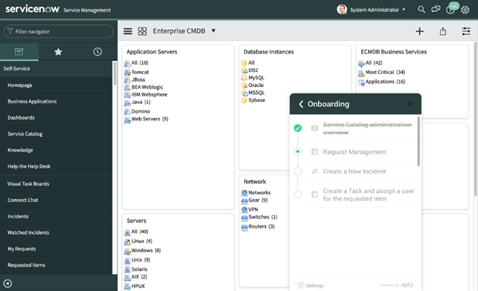
- Change Sentiment Analysis: Apty’s AI monitors user interactions to gauge sentiment toward new systems or processes, allowing change leaders to address resistance hotspots before they impact implementation.
- Automated Change Reinforcement: For critical processes, Apty’s AI can provide automated reinforcement, ensuring consistent execution during the transition period when errors are most likely.
Eliminating Change Friction Across the Enterprise
Apty doesn’t just help users navigate new software—it fundamentally transforms how organizations manage change by removing friction at every stage of the transformation journey:
For End Users Experiencing Change
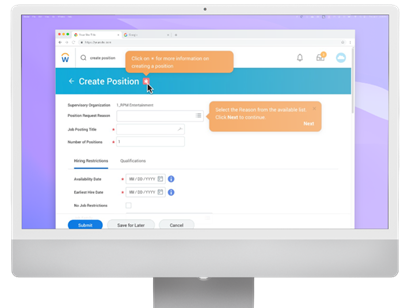
- Simplified New Processes: Apty breaks down complicated new workflows into intuitive, guided experiences
- In-App Change Support: Contextual help exactly when and where it’s needed during transitions
- Cross-Application Change Guidance: Seamless assistance across multiple applications affected by transformation
For Change Management Leaders
- Accelerated Change Adoption: 40% faster acceptance of new technologies and processes
- Reduced Change Resistance: 65% decrease in help desk tickets related to new applications
- Enhanced Change Compliance: 90% improvement in adherence to new protocols and procedures
For Business Transformation Leaders
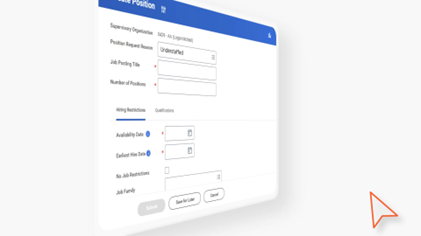
- Change Readiness Insights: Real-time visibility into organizational readiness for digital transformation
- Process Standardization During Transition: Consistent execution of critical business processes during change
- Measurable Transformation Impact: Direct correlation between change initiatives and business KPIs
The Apty Change Management Implementation Advantage
Unlike competitors who require extensive professional services and lengthy change management cycles, Apty delivers transformation value with remarkable speed and simplicity:
- Rapid Change Deployment: Implementation in weeks, not months, accelerating time-to-value
- No-Code Change Configuration: Change managers can create and modify guidance without IT involvement
- Seamless Integration with Change Tools: Works with your existing change management stack
- Modular Change Approach: Start with specific transformation use cases and expand as value is proven
Real-World Success: Change Management Outcomes
These case studies demonstrate how organizations across various industries have utilized AI-based change management software (Apty) to facilitate successful digital transformations.
Case Study 1: ChenMed: Driving Adoption of Workday HCM Through Digital Guidance
Challenge
ChenMed, a physician-led primary care provider, faced significant challenges in driving the adoption of its newly implemented Workday Human Capital Management (HCM) system. Employees struggled with the complex interface and workflows, resulting in low utilization rates and a poor return on their technology investment.
Solution
ChenMed partnered with Apty, a digital adoption platform, to transform its change management approach. Apty’s solution provided:
- In-application guidance with step-by-step walkthroughs
- Contextual help at the moment of need
- Personalized training paths based on user roles
- Analytics to identify adoption barriers in real-time
Results
- Accelerated time-to-proficiency for employees using Workday HCM
- Increased system utilization across all departments
- Reduced support tickets and training costs
- Improved employee satisfaction with the new technology
- Enhanced data quality and reporting capabilities
By addressing the human side of technology change with contextual guidance, ChenMed successfully transformed its digital adoption strategy and maximized its return on investment in Workday HCM.
Case Study 2: Global Conglomerate: Streamlining Multi-System Training Through Unified Digital Adoption
Challenge
A global conglomerate with operations across multiple industries was struggling with fragmented training approaches across its diverse technology ecosystem. With employees needing to master multiple enterprise applications, traditional training methods were proving ineffective, costly, and impossible to maintain as systems were continuously updated.
Solution
The organization implemented Apty’s digital adoption platform as part of a comprehensive change management strategy to:
- Create a unified training approach across multiple software systems
- Develop consistent, always-current guidance that automatically updated with system changes
- Provide contextual help within each application at the moment of need
- Collect usage analytics to identify adoption barriers and optimization opportunities
Results
- Reduced training time by providing just-in-time guidance instead of extensive pre-launch training
- Streamlined the onboarding process for new employees across all systems
- Created a consistent user experience across their technology ecosystem
- Enabled continuous improvement through detailed analytics on user behavior
- Significantly improved adoption rates across all enterprise applications
By implementing a digital adoption platform as a cornerstone of their change management strategy, the global conglomerate created a scalable approach to managing technology change across its complex organization.
The Future of Change Management is AI-Powered
In a world where digital transformation initiatives frequently fail to deliver expected outcomes, Apty stands as the essential bridge between technology implementation and successful change. By removing digital friction, simplifying complex transitions, and delivering measurable outcomes, Apty ensures that your change management initiatives finally deliver the business results you expect.
Every day without Apty is a day of wasted change management effort and delayed transformation ROI. In the AI-powered future of work, Apty isn’t just a better DAP—it’s the strategic advantage that transforms how organizations manage change.
Change should drive outcomes. Apty makes sure it does.
Apty vs. Traditional Tools: Change Management Capability Comparison
The following charts illustrate how Apty capabilities compare to traditional change management tools across key dimensions:
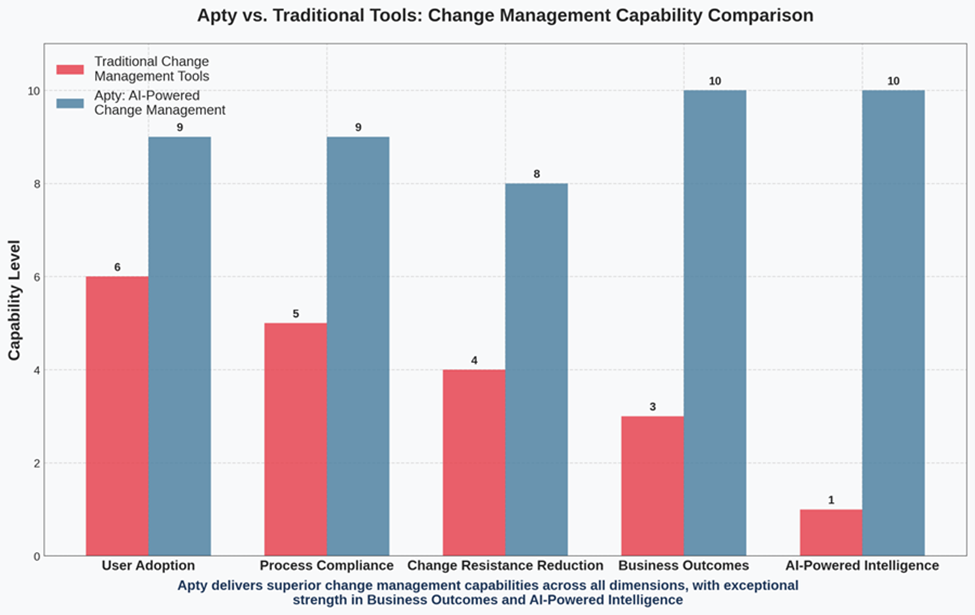
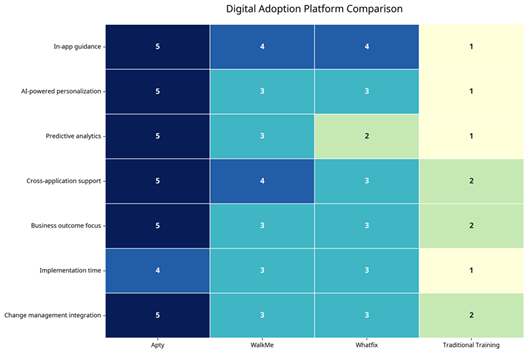
Apty AI-Powered Change Management Capabilities
Apty’s advanced AI engine delivers intelligent, contextual support throughout the change management process:
Measurable Change Management Outcomes with Apty
Apty delivers quantifiable change management results that transform how organizations implement new technologies:
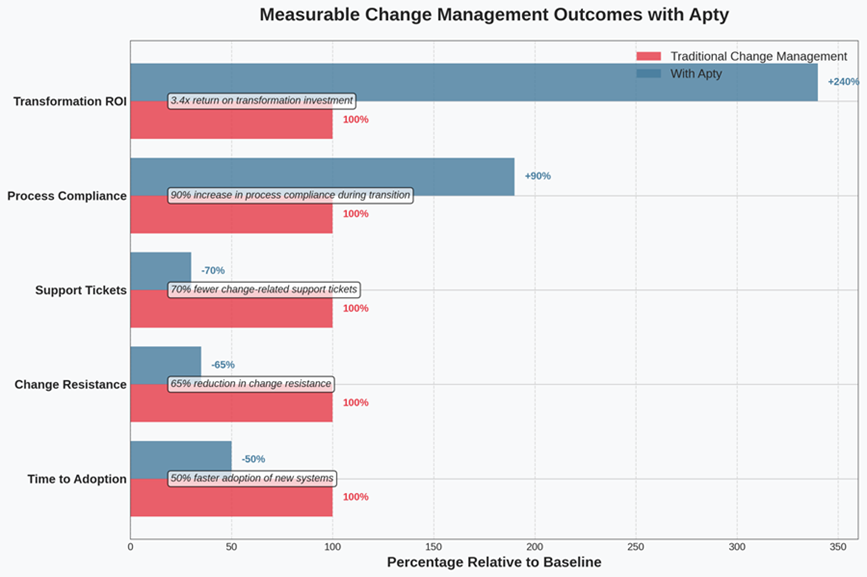
Conclusion: Embracing Change as a Strategic Advantage
Change management has evolved beyond a mere component of digital transformation initiatives—it’s now the essential bridge between technology implementation and the realization of business value. In today’s fast-paced business environment, companies that excel in change management gain a distinct competitive edge.
Gone are the days when change was seen as a one-time event. Modern enterprises embrace continuous transformation, recognizing change as a constant that drives innovation and resilience.
By understanding the psychological and neurological factors behind resistance to change, organizations can turn these natural challenges into opportunities for growth. The most successful companies don’t just overcome resistance—they use it as fuel for improvement, fostering a culture of innovation.
The integration of AI and automation into change-management processes marks a significant milestone including WhatsApp Automation which enables personalized customer messaging and business workflow integration.
These technologies don’t replace human involvement; rather, they enhance it, offering valuable insights, reducing administrative burdens, and providing personalized support at scale.
The shift from activity-based metrics to outcome-focused measurements has revolutionized how organizations evaluate change success. This evolution ensures that change initiatives are not only aligned with strategic business objectives but also deliver tangible, measurable results.
In embracing change, companies position themselves to not only adapt to disruptions but to lead them, turning challenges into opportunities for sustained growth and competitive advantage.
The Path Forward
For organizations embarking on digital transformation journeys, the path forward is clear:
- Invest in change capability as a core business function, not a project-specific activity
- Adopt AI-powered change management tools that provide real-time insights and personalized guidance
- Implement structured methodologies that can be consistently applied across the organization
- Develop change leadership at all levels, particularly among middle managers
- Create a culture of continuous adaptation where change becomes the expected norm
The Apty Advantage
Apty’s AI-powered Digital Adoption Platform stands as the essential solution for organizations seeking to master change management in the digital era. By removing friction, simplifying complex processes, and delivering measurable business outcomes, Apty transforms how organizations implement and sustain change.
In a world where 70% of digital transformation initiatives fail to achieve their objectives, the organizations that thrive will be those that recognize change management not as a cost center but as a value creator—the critical factor that determines whether technology investments deliver their promised returns.
The future belongs to organizations that don’t just manage change but master it. With the right approach, methodologies, and tools, your organization can be among them.
Change should drive outcomes. Apty makes sure it does.
Transform Your Change Management Strategy with Apty
Ready to see how Apty can transform your organization’s change management approach? Contact us today to schedule a personalized demonstration and discover how our AI-powered, outcome-focused solution can deliver measurable results for your digital transformation initiatives.
